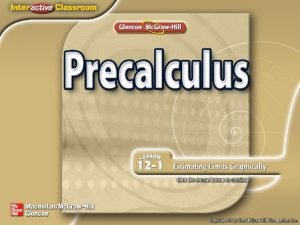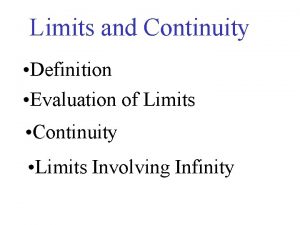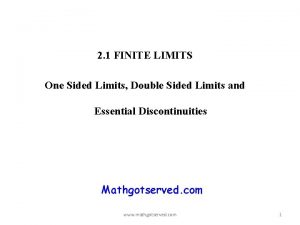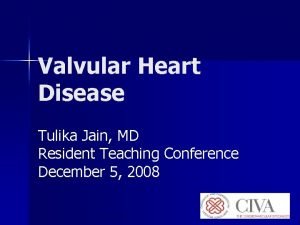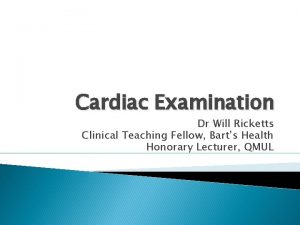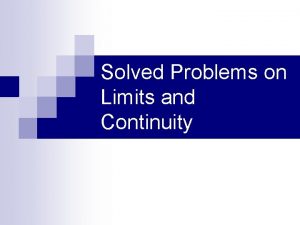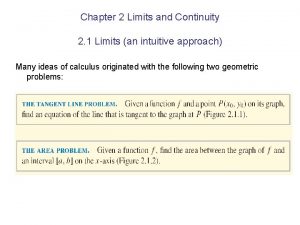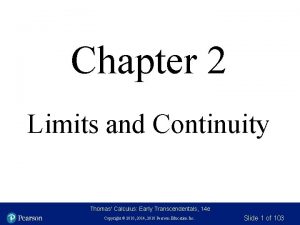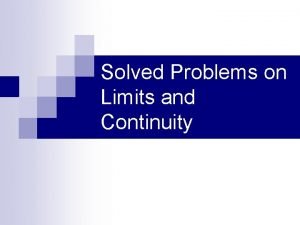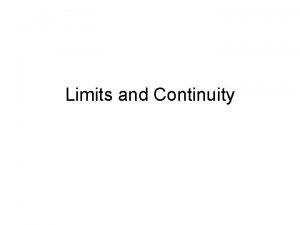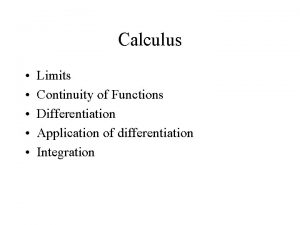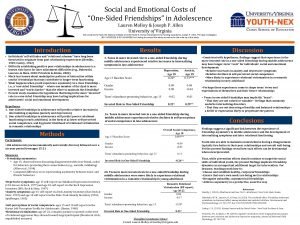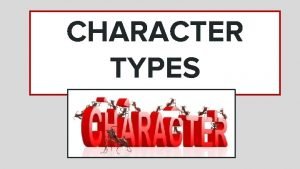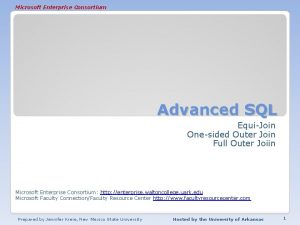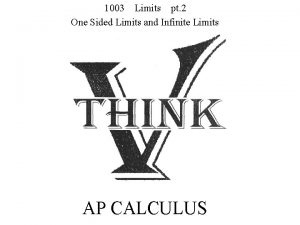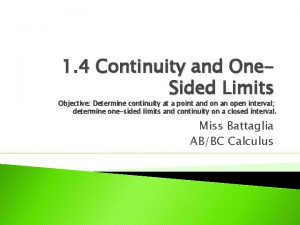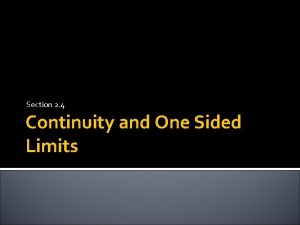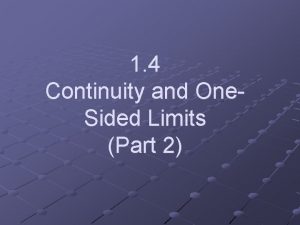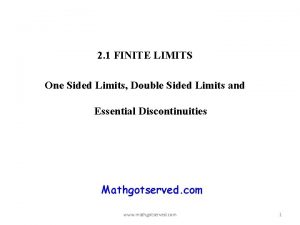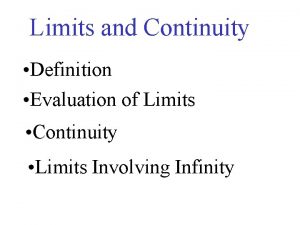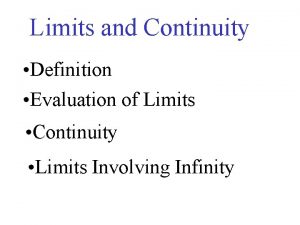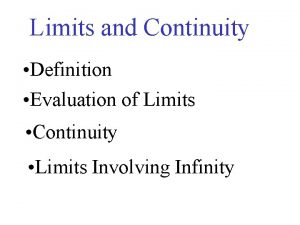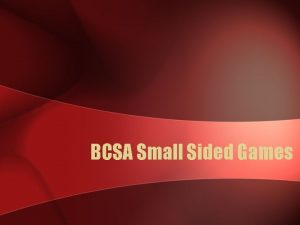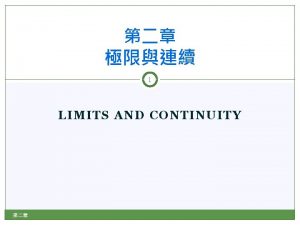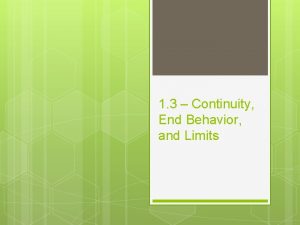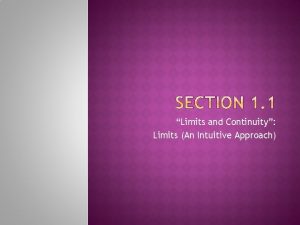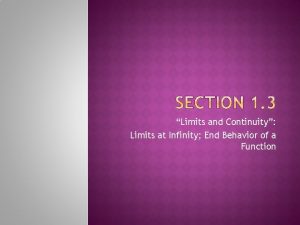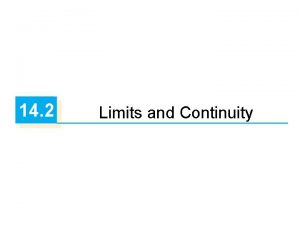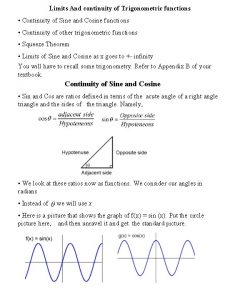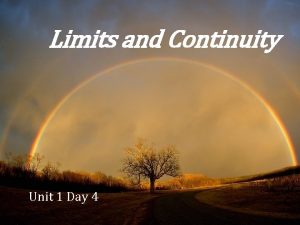Continuity and One Sided Limits 2 4 Continuity










![Intermediate Value Theorem • If f continuous on the closed interval [a, b] and Intermediate Value Theorem • If f continuous on the closed interval [a, b] and](https://slidetodoc.com/presentation_image_h2/afcdbbf46308e5dcc037e7abb6852429/image-11.jpg)











- Slides: 22

Continuity and One Sided Limits 2. 4

Continuity Definition (with limits) • Continuity at a point: A function f(x) is continuous at point c if the following three condition are met: • 1) f(c) is defined • 2) • 3) exists

Continuity on an Open interval • A function is continuous on an open interval (a, b) if it is continuous at each point in the interval. A function continuous on the entire real line is said to be everywhere continuous.

Types of discontinuity • Removable discontinuity- a discontinuity at c is removable if the function f can be made continuous by redefining f(c). • Ex. Holes • Nonremovable discontinuity- if the function can not be made continuous by redefining a point (or finite set of points) • Ex. Asymptotes, Jump discontinuity

Continuity of a Function Examples • Is each function continuous or are there discontinuities? If so are the discontinuities removable or non-removable. • a) b) • c) d)

One-Sided Limits • Limit from the right (Right Hand Limit) means that x approaches c from values greater than c. • Limit from the left (Left Hand Limit) means that x approaches c from values less than c.

The Existence of a Limit • Let f be a function and let c and L be real number. The limits of f(x) as x approaches c is L if and only if And

Continuity on a Closed interval • A function is continuous on an closed interval [a, b] if it is continuous on the open interval (a, b) and • The function f is continuous from the right at a and continuous from the left at b

Properties of Continuity • If b is a real number and f and g are continuous at x = c, then the following function are also continuous at c. • • 1) Scalar multiple 2) Sum and difference 3) Product 4) Quotient if

Continuity of a Composite Function • If g is continuous at c and f is continuous at g(c), then the composite function f(g(x)) is continuous at c.
![Intermediate Value Theorem If f continuous on the closed interval a b and Intermediate Value Theorem • If f continuous on the closed interval [a, b] and](https://slidetodoc.com/presentation_image_h2/afcdbbf46308e5dcc037e7abb6852429/image-11.jpg)
Intermediate Value Theorem • If f continuous on the closed interval [a, b] and k is any number between f(a) and f(b), then there is at least one number c in the interval [a, b] such that f(c)= k This is very useful because if we have two output values of different signs, it tells us that a zero (root) must exist between them.

Using the Intermediate Value theorem • Show that the polynomial has a zero in the interval [0, 1]. To actually find the zero we could use the “bisection method”. If we know that a zero falls in an interval [a , b]. We can split it into two intervals and Using the sign of (a + b)/2 we can determine which interval the zero falls in, and narrow in on this. We can repeat this process until we have located the zero.

Infinite Limits • Let’s examine two limits numerically (by plugging values into a table) from both the left and the right.

Approaching from the right x 0. 1 0. 001 0. 0001 Approaching from the left x -0. 1 -0. 001 -0. 0001

Approaching from the right x 0. 1 0. 001 0. 0001 Approaching from the left x -0. 1 -0. 001 -0. 0001

Infinite Limits Means that we can make f(x) arbitrarily large for all x values sufficiently close to x = c from both sides without actually letting x = c. Means that we can make f(x) arbitrarily “large” and negative for all x values sufficiently close to x = c from both sides without actually letting x = c.

Infinite limits still do not exist! • The equal sign in the statement does not mean the limit exists. It tells you the limit fails to exist by showing that f(x) is unbounded as x approaches c.

Vertical Asymptotes • If f(x) approaches infinity (or negative infinity) as x approaches c from the right or left, then the line x = c is a vertical asymptote of the graph of f.

Determine the vertical asymptotes of the graphs of each function

Properties of Infinite limits Let c and L be real numbers and let f and g be functions: 1) Sum or difference: 2) Product: 3) Quotient:

Use Infinite Limits and their Properties to Determine the following Limits

Hw • Continuity • Page 100 - 83 -91 odd 92, 93, 108 • Infinite limits • Page 108 1, 9, 11, 13, 23, 39, 43, 47, 48, 49, 51, 67
 Estimate each one-sided or two-sided limit, if it exists.
Estimate each one-sided or two-sided limit, if it exists. Limits
Limits Difference rule limits
Difference rule limits Limit involving infinity
Limit involving infinity Right sided vs left sided murmurs
Right sided vs left sided murmurs Holosystolic murmur
Holosystolic murmur Parasternal heave
Parasternal heave Real limits vs. apparent limits
Real limits vs. apparent limits Limit and continuity solved problems
Limit and continuity solved problems Limits
Limits Thomas calculus limits and continuity
Thomas calculus limits and continuity Limit and continuity solved problems
Limit and continuity solved problems Limits and continuity
Limits and continuity Application of limits and continuity
Application of limits and continuity Absolute continuity implies uniform continuity
Absolute continuity implies uniform continuity One-sided friendship psychology
One-sided friendship psychology Main vs minor character
Main vs minor character Doublespeak adalah
Doublespeak adalah One sided outer join
One sided outer join One face one voice one habit and two persons
One face one voice one habit and two persons One god one empire one religion
One god one empire one religion One one one little puppy run
One one one little puppy run One king one law one faith
One king one law one faith
